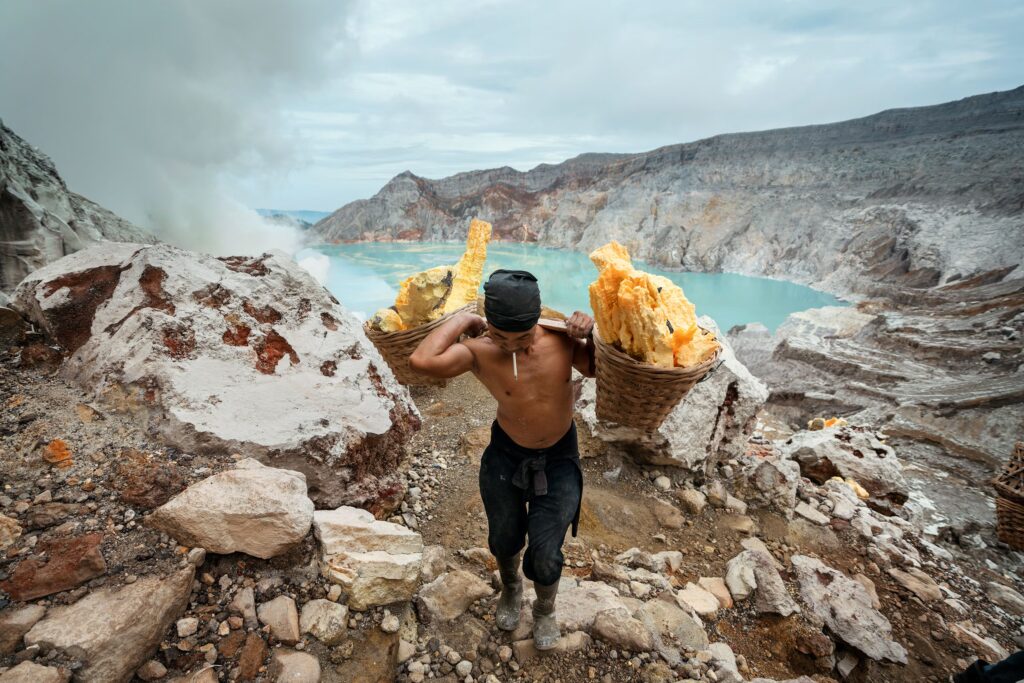In the heart of East Java, Indonesia, lies one of the most surreal and challenging landscapes on Earth: the Ijen Crater. Known for its stunning turquoise acid lake and the eerie blue flames that dance in the night, the Ijen Crater is also home to a sulfur mining operation that has remained almost unchanged for centuries. Here, miners risk their health daily to extract bright yellow sulfur from one of the world’s most volatile volcanic environments.
This is a story of resilience, danger, and the raw power of nature — where human endurance meets the extremes of the natural world.
The Volcanic Heart of Ijen
Mount Ijen is not just a volcano; it’s a sprawling volcanic complex with a massive crater lake at its center. This lake, the largest acidic crater lake in the world, is rich in sulfuric acid and brimming with vibrant turquoise waters that contrast sharply with the barren, yellow-stained crater walls.
At night, visitors witness an otherworldly phenomenon: blue flames flickering along the crater’s fissures. These flames are caused by ignited sulfuric gases escaping from cracks in the earth, lighting up the darkness in ghostly hues. This rare spectacle draws adventurous travelers worldwide, but it’s the miners themselves who have the most intimate relationship with this fiery landscape.
The Grueling Work of Sulfur Miners

Each day, sulfur miners descend into the crater carrying heavy loads of solidified sulfur—chunks that weigh anywhere from 70 to 90 kilograms (150 to 200 pounds). They haul these burdens on their backs up the steep, rocky path to the crater rim and then down to the base camp, where the sulfur is weighed and sold.
This work is backbreaking. The miners earn mere dollars per load, often working long hours in hazardous conditions. The sulfur itself is sharp and brittle, and miners risk cuts and abrasions. More dangerously, they inhale toxic sulfur dioxide gas, which can cause respiratory issues, eye irritation, and long-term health damage.
Most miners don’t wear protective gear, making their perseverance even more astonishing. Their resilience is a testament to human endurance in the face of nature’s extremes.
The Blue Flames: Nature’s Fiery Dance

The Ijen blue flames have become iconic for their surreal beauty. Unlike normal volcanic lava, these flames are the result of sulfur gas combustion at high pressure and temperature. When sulfuric gas emerges from underground fissures and meets oxygen in the air, it ignites spontaneously, producing a blue flame that can reach up to 5 meters high.
The best time to witness this phenomenon is in the early hours before dawn, when darkness heightens the flames’ otherworldly glow. It’s a haunting reminder that beneath the serene lake surface and vibrant landscape lies a volatile, living Earth.
Cultural and Economic Importance
The sulfur mined at Ijen isn’t just a geological curiosity—it has been a vital commodity for local communities for generations. Sulfur is used in various industries, including fertilizer production, rubber vulcanization, and traditional medicines.
Despite the harsh conditions, sulfur mining provides livelihoods for many families around the crater. The work supports local economies but also raises questions about labor rights, environmental impacts, and the need for better safety measures.
Tourism and Ethical Considerations

Ijen Crater has become an increasingly popular destination for adventurous tourists, drawn by the promise of blue flames and rugged natural beauty. Trekking to the crater involves a challenging hike, but the reward is unforgettable.
However, tourism has brought its own challenges. While it can bring economic benefits, it also risks disrupting fragile ecosystems and the miners’ way of life. Visitors must tread respectfully, understanding the gravity of the miners’ work and the delicate balance between human activity and nature.
Environmental Challenges
The Ijen volcanic complex is a dynamic system, with constant changes in gas emissions and volcanic activity. The acidity of the crater lake and the presence of sulfur gases create a harsh environment where few plants or animals can thrive.
Mining activities also affect the local environment, from waste sulfur piles to potential contamination. Conservation efforts focus on balancing human needs with ecological preservation, ensuring that the crater remains a unique natural wonder.
Final Thoughts
The Sulfur Mines of Ijen Crater represent an extraordinary intersection of human courage and natural wonder. Here, in a place that seems almost alien, miners endure tremendous physical hardship to harvest one of nature’s elemental substances. Meanwhile, the surreal beauty of the blue flames and turquoise lake remind us of Earth’s raw, untamed power.
Visiting Ijen is more than a tourist adventure—it’s a chance to witness a world where geology and humanity collide, and to honor the people whose daily struggle unfolds beneath the glow of blue fire.
